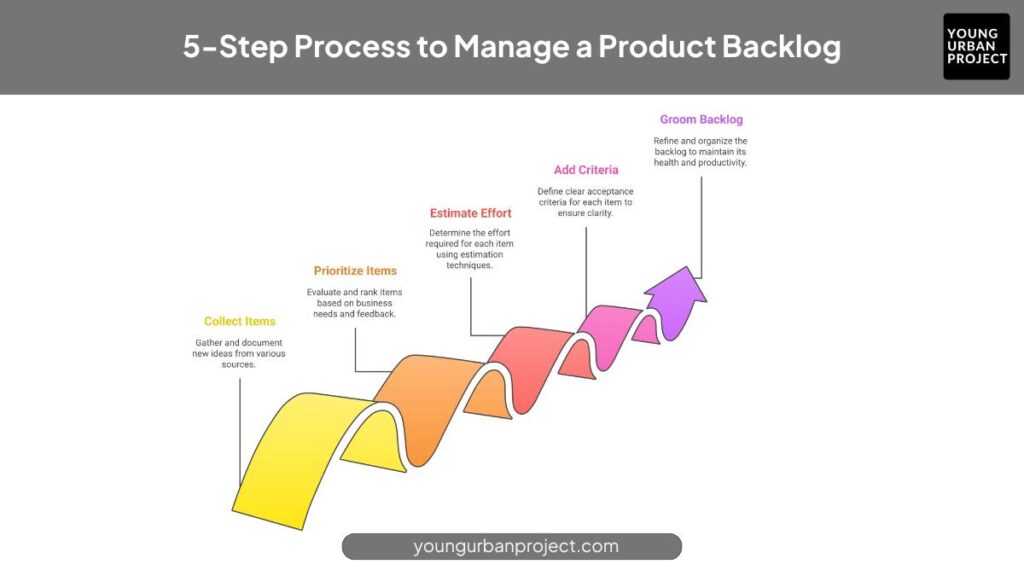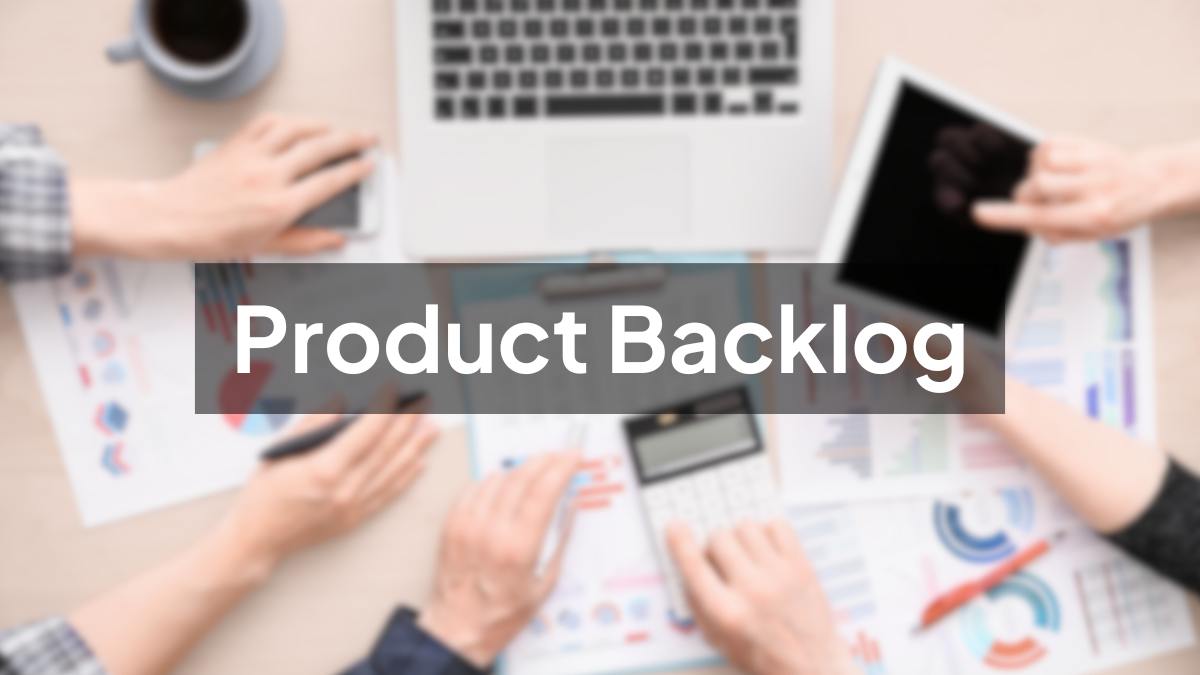Let’s be honest – product development can feel a bit like juggling flaming swords. Between deadlines, user needs, business goals, and constant iterations, it’s easy to lose track of what needs to get done right now and what can wait.
That’s where the product backlog steps in. In Agile product development, the product backlog is one of the most important tools. It brings order to chaos. It’s not just a to-do list, it’s a living, breathing document that guides your entire product journey.
In this blog, we’ll break down:
- What is Product Backlog
- Why it matters in Agile and Scrum
- How to create and manage one effectively
- Real-world examples
- And answers to common questions
Whether you’re a product owner, Agile newbie, or just curious about how teams organize their work, this one’s for you.
Also Read: What Is an Epic in Agile
Table of Contents
What is Product Backlog?
In the simplest terms, a product backlog is a prioritized list of work that needs to be done to improve a product.
Think of it like your product’s master to-do list. It includes everything from new features and UI tweaks to bug fixes and technical upgrades.
In Agile and Scrum, the backlog is more than a static list. It evolves constantly, items get added, removed, re-prioritized, and reshaped as your product (and user feedback) grows. It’s the heart of Agile planning.
Why it Matters
Without a clear backlog, Agile teams can easily lose focus. You might end up solving problems that don’t really matter or wasting resources on low-impact ideas. The backlog helps everyone stay aligned on what’s most valuable, both for the user and the business.
Key Components of a Product Backlog
A well-crafted backlog isn’t just a random dump of ideas. It includes specific types of items, each serving a unique purpose:
- User Stories: Short descriptions of a feature from the end-user’s perspective. (“As a user, I want to… so that…”)
- Features & Enhancements: Bigger improvements or changes to the existing product.
- Bug Fixes: Reported errors or issues that need attention.
- Technical Tasks: Backend improvements, refactoring, or infrastructure upgrades.
- Research/Spikes: Time-boxed tasks to explore unknowns or test a concept before committing.
Also Read: Agile vs Waterfall: Key Differences
How Product Backlog Fits Into Agile Framework
If you’re working in Scrum, Kanban, or even some hybrid model, the product backlog plays a central role.
- In Scrum, the backlog feeds directly into sprint planning. The team pulls the highest-priority items from the product backlog into the sprint backlog.
- In Kanban, it’s more continuous, teams pull items as capacity allows.
- In product roadmapping, the backlog connects near-term execution with long-term goals.
It’s used by:
- Product Owners to prioritize work
- Developers need to know what to build next
- Designers need to understand user needs
- Stakeholders to track what’s coming up
How to Create an Effective Product Backlog
Creating a backlog from scratch? Here’s a high-level approach that works:
1. Set a Clear Vision and Goals
Before adding tasks, understand the “why.” What’s your product trying to achieve? What problem does it solve?
2. Gather Initial Requirements
Talk to stakeholders, customers, and your team. Capture ideas, pain points, feature requests, everything. You can refine later.
3. Prioritize Ruthlessly
Not everything is urgent. Use frameworks like MoSCoW (Must have, Should have, Could have, Won’t have) or Value vs Effort to decide what to do first.
4. Write Clear, Actionable Stories
Follow the INVEST criteria: Independent, Negotiable, Valuable, Estimable, Small, Testable.
5. Keep it Evolving
The backlog isn’t a one-time setup. You’ll continuously add, delete, split, merge, or update items as the product and market evolve.
5-Step Process to Manage a Product Backlog

1. Collect and Document New Items
New ideas can come from anywhere, customers, support tickets, competitors, analytics, or even random thoughts in the shower. The key is to capture them fast. Use a shared tool (like Trello or Jira) so nothing slips through the cracks. Don’t worry about refining yet, just log the idea clearly enough to remember the context later.
2. Prioritize Regularly
Not all backlog items are created equal. Some features bring big wins; others can wait. You should revisit your backlog at least every sprint (or bi-weekly) and adjust priorities based on business needs, deadlines, customer feedback, or team capacity. Use frameworks like MoSCoW or Value vs Effort to make tough calls simpler.
3. Estimate Effort
Once items are prioritized, the team needs to understand how much work each one might take. This isn’t about perfect accuracy, it’s about rough sizing. You can use story points, t-shirt sizing, or other estimation techniques. Bring developers into this conversation early, they’ll often spot complexities that aren’t obvious at first.
4. Add Acceptance Criteria
To avoid confusion later, write down exactly what “done” looks like for each backlog item. Acceptance criteria help ensure everyone, devs, testers, designers, is on the same page. They also guide QA and reduce back-and-forth. Think of them as a checklist that defines the scope of the story.
5. Groom (or Refine) the Backlog
Regular refinement (aka backlog grooming) is where you clean, polish, and organize. It’s time to clarify vague tasks, break down large items into smaller ones, and remove irrelevant or outdated entries. Try to involve the whole team. Refinement sessions aren’t just admin; they keep your backlog healthy and your sprints productive.
Also Read: Psychographic Segmentation

Enroll Now: Product Marketing Course
Product Backlog vs Sprint Backlog: A Detailed Comparison
| Aspect | Product Backlog | Sprint Backlog |
| Definition | A dynamic, prioritized list of all work that could be done on the product | A fixed set of tasks the team commits to complete during a specific sprint |
| Time Horizon | Long-term, spans weeks, months, or even the full product lifecycle | Short-term, typically focused on the current sprint (1–4 weeks) |
| Ownership | Managed by the Product Owner | Owned and maintained by the Development Team |
| Change Frequency | Frequently updated, items can be added, removed, or re-prioritized anytime | Locked during the sprint, changes are discouraged until the next sprint cycle |
| Content Types | Features, bugs, technical tasks, research, spikes, basically, anything valuable | Only selected stories/tasks from the product backlog deemed ready for delivery |
| Purpose | To provide a complete view of all potential work and support strategic planning | To help the team focus on delivering a subset of work with clear goals |
| Level of Detail | Varies, some items may be vague or high-level until refined | Detailed and well-defined, with clear acceptance criteria and estimates |
| Visibility | Shared with stakeholders, execs, and broader team | Mostly internal to the development team during the sprint |
| Tools Commonly Used | Jira, Trello, Asana, ClickUp | Often the same tools, but filtered to show only current sprint tasks |
| Analogy | A full buffet with everything available to eat (eventually) | The plate you serve yourself from the buffet, and what you’re eating right now |
Who Owns and Manages the Product Backlog?
Technically, the Product Owner is the main owner of the backlog. They’re responsible for:
- Prioritizing items
- Clarifying requirements
- Ensuring the backlog reflects the product vision
But they don’t work alone.
- The Scrum Master facilitates refinement and removes blockers.
- The Development Team provides estimates, technical input, and can suggest new backlog items.
- Stakeholders (like marketing, sales, support) offer feedback and feature requests.
So it’s a team effort, but the Product Owner has the final say.
Also Read: Top 30 AI Tools for Digital Marketing
Tips for Backlog Optimization
Keeping your backlog useful, not just cluttered, is the real challenge. Here are a few tips:
- Review it weekly: Backlogs age fast. A stale backlog becomes a graveyard of forgotten ideas.
- Keep it lean: Don’t let it grow into a 500-item monster. Archive outdated stuff.
- Use labels and filters: Helps you find what matters quickly.
- Don’t skip refinement sessions: These are critical to staying Agile.
- Avoid vague tasks: “Improve UI” isn’t helpful. Be specific.
- Involve the whole team: Developers and designers bring valuable perspectives.
Also Read: What is Geofencing Marketing?
Conclusion
The product backlog isn’t just a tool, it’s a mindset. It helps Agile teams stay focused, adapt to change, and deliver real value continuously.
When managed well, it keeps everyone, from stakeholders to devs, moving in the same direction.
It’s not perfect, and sometimes it gets messy. But with regular care and collaboration, it becomes the backbone of your product’s success.
FAQs
Q1: What’s the difference between a product backlog and a product roadmap?
A roadmap shows the high-level direction. The backlog is the detailed execution plan. Roadmap = strategy. Backlog = tasks.
Q2: Who writes user stories in the backlog?
Usually, the Product Owner, but developers, designers, and even users can contribute ideas. The key is collaboration.
Q3: How often should a product backlog be reviewed?
Ideally ,every sprint, at least once every 1-2 weeks. Priorities change fast.
Q4: Can the development team add items to the product backlog?
Yes! In fact, they should. Technical improvements or bug fixes often come from the dev team.
Q5: What tools are best for managing a backlog?
Popular ones include Jira, Trello, ClickUp, Notion, and Asana, choose based on your workflow.
Q6: Is a product backlog necessary for non-Agile teams?
Maybe not mandatory, but it still helps. Any team working on complex projects benefits from having a prioritized task list.

